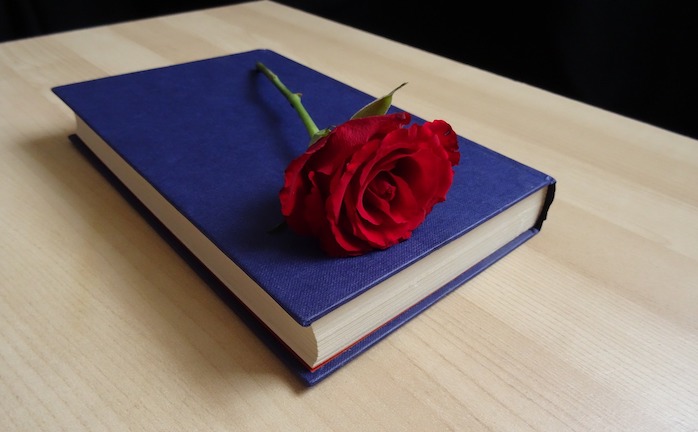Writing Poetry, Part 4
So far we have looked only at separate lines, noting their rhythm, length, sounds and rhymes. The arrangement of lines together is our next subject.

Have stood against the world; now lies he there,
And none so poor to do him reverence.
You see that it is iambic rhythm, five feet in each line, and that the lines follow one another without rhyme. This is what is called Blank Verse. It is the simplest arrangement of lines possible; yet it is usually conceded to be the most difficult to write well, from its very plainness and near approach to prose form. It is usually employed in plays and dramatic poems, since speech sounds more natural in it than in rhyme. That it is capable of great power and beauty, Shakespeare's plays bear witness. Occasionally four-foot iambic lines are unrhymed; so is dactylic hexameter as a rule. Other lines usually have rhyme. Next notice this :
And stopped at last where in a sunny bay
The green Anaurus cleaves the white sea sand
And eastward inland doth Mount Pelion stand.
You see that the rhythm and meter are the same as in Blank Verse, but that the lines rhyme in pairs. Lines rhymed in this way are called couplets; and when, as here, they are of iambic pentameter, they are called Heroic Couplets, from its frequent use in long narrative poems, such as Pope's translation of the "Iliad." It is a form that is apt to fall on the ear unless run-on lines are frequently employed, and the rhyming words are unusually fine. Couplets of shorter lines and other rhythms are frequently found.
Beyond the path of the outmost sun, through utter darkness hurled—
Further than ever comet flared or vagrant star-dust swirled—
Live such as fought and sailed and ruled and loved and made the world.
This arrangement of three successive lines with one rhyme is called a triplet.
Any such group of lines, be it a couplet, a triplet, or of four or more lines, forming a regular division of a poem, is called a stanza.
A study of the poets will give one some idea of the great variety and the possibilities of the different kinds. For unusual and striking stanzas Kipling is exceptional.
A very simple stanza is this:
Who joined him laughing eyed;
They sent against him thirty men
And they remained beside.
You will observe that the lines are iambic, the first and third of four feet and not rhymed, the second and fourth of three feet, and rhyming with each other. From its use by the early ballad writers this is called Ballad Measure. It is still used for simple narrative poems and little songs.
A similar stanza has the first and third lines rhymed, as well as the second and last. Another has all the lines of four feet. In fact, four-line stanzas, or quatrains, are made of all rhythms and line lengths. A familiar one is this, of iambic pentameter:
The lowing herd winds slowly o'er the lea,
The ploughman homeward plods his weary way
And leaves the world to darkness and to me.
The quatrain used in 'In Memoriam" has a different arrangement of rhymes, the first and fourth rhyming together, and the second and third, thus:
The holly round the Christmas hearth;
A rainy cloud possessed the earth,
And sadly fell our Christmas eve.
Another quatrain is this:
Night and day she on me cries,
And I am weary of the skies
For her sake that died for me.
In this case the fourth line rhymes with the fourth of the next stanza. A good five-line stanza is this:
Prithee, why so pale? Will, when
looking well can't move her.
Looking ill prevail?
Prithee, why so pale?
There are other good five-line stanzas, and many of six lines, of which these two are good examples:
Like little mice stole in and out
As if they feared the light.
But, oh! she dances such a way
No sun upon the Easter day
Is half so fine and bright.
Oh hame, hame, hame to my ain countree.
There's an eye that ever weeps and a fair face will be fain
As I pass through Annan-water with my bonnie bands again.
When the flower is in the bud, and the leaf upon the tree,
The lark shall sing me hame in my ain countree.
In all the stanzas given so far you see that the arrangement of rhymes is comparatively simple. One with a milch more intricate rhyme-scheme is this:
Between the sun and moon upon the shore;
And sweet it was to dream of Fatherland,
Of child, and wife, and slave; but evermore
Most weary seemed the sea, weary the oar,
Weary the wandering fields of barren foam..
Then someone said, "We will return no more;"
And all at once they sang, "Our island home
Is far beyond the wave; we will no longer roam."
Notice, beside the order of rhymes, that the first eight lines have five feet and the ninth has six; the whole nine being iambic. This is called the Spenserian stanza, from its use in the Faerie Queene.
Songs and lyric poems and short narrative poems frequently have one or more lines repeated at the end of each stanza as a refrain. Sometimes the refrain is also used within the stanza, in which case it is usually but one line. A good refrain catches the ear, and goes far to insure the popularity of a song. The vogue of "Mandalay" is largely due to its capital three line refrain.
The stanza in verse corresponds to the paragraph in prose, and like it should embody one thought or part of the whole. Occasionally a sentence runs on from one stanza into another, especially when the stanzas are short ones, but as a rule it is best to end the sentence and stanza together.
The sonnet is an intricate verse-form generally used to embody a serious thought or an impassioned mood. The rhythm is iambic, and the meter has five feet. The number of the lines is always fourteen. So far it is simple; the intricacy lies in the arrangement of its rhymes. Notice this example:
And many goodly States and Kingdoms seen;
Round many Western islands have I been
Which bards in fealty to Apollo hold.
Oft of one wide expanse had I been told
That deep-brow'd Homer ruled as his demesne:
Yet did I never breathe its pure serene
Till I heard Chapman speak out loud and bold;
Then felt I like some watcher of the skies
When a new planet swims into his ken;
Or like stout Cortez when with eagle eyes
He started at the Pacific, and all his men
Look'd at each other with a wild surmise!
Silent, upon a peak in Darien.
You see that the first eight lines, called the octette, are arranged in two quatrains, and have but two rhymes, the first, fourth, fifth and eighth lines rhyming together, and the second, third, sixth and seventh. This arrangement of rhymes may be denoted by letters, thus, a, b, b, a, a, b, b, a. The last six lines, called the sextette, in this sonnet rhyme alternately on two rhymes, c, d, c, d, c, d. Sometimes the octette lines are arranged thus: c, d, e, c, d, e, or c, d, d, e, c, e, or c, d, e, c, e, d. There are other arrangements, also, of the sextette rhymes, Three rhymes are used for it more often than two.
The sonnet form given above is generally called the Italian, and is used in English by Milton, Keats, Wordsworth, and many others. The sonnet as used by Shakespeare is different in its rhyme scheme, though in nothing else. Its rhymes are arranged as follows: a, b, a, b, c, d, c, d, e, f, e, f, g, g.
The sonnet should always have strong opening and closing lines, and a dignified and genuinely poetical sentiment and treatment.
The following sonnet by Shakespeare is often cited as one of the best; a careful study of it will teach the ambitious poet a very great deal.
beweep my outcast state, And trouble deaf
heaven with my bootless cries, And look upon myself
and curse my fate, Wishing me like to one more rich in
hope, Featured like him, like him with friends
possess'd, Desiring this man's art and that man's scope,
With what I most enjoy contented least; Yet in these thoughts
myself alone despising, Haply I think on
these, and then my state, Like to the lark at break of
day arising From sullen earth, sings hymns at
heaven's gate; For thy sweet love remember'd such
wealth brings That then I scorn to change my state
with kings.
In the last thirty years or so there has been a revival in English of certain intricate verse-forms used by early French lyric writers. A full account of these forms with many examples may be found in a volume called "Ballades and Rondeaus," edited by Gleeson White, and published by Appleton & Co. Of these forms—the ballade, rondeau, rondel, triolet, chant royal, restina, villanelle, etc.—we can say but little in a brief article. They all have fixed laws of rhymes and refrains, and of number of lines, which make it difficult to avoid stiffness; they require exquisite skill. In the rhythms and meters considerable liberty is allowed; the ballade, for instance, may be written in trimeter, tetrameter or pentameter, and in iambic, anapaestic or dactylic rhythm. Frequently combinations of iambic and anapaestic feet are used, while dactylic lines generally end with a strong syllable, as in this example:
Painted by Carlo Vanloo,
Loves in a riot of light,
Roses and vaporous blue;
Hark to the dainty frou frou!
Picture above if you can,
Eyes that could melt as the dew—
This was the Pompadour's fan!
See how they rise at the sight,
Thronging the Oeil de Boeuf through,
Courtiers as butterflies bright,
Beauties that Fragonard drew.
Talon-rouge, falbala, queue,
Cardinal, Duke—to a man,
Eager to sigh or to sue—
This was the Pompadour's fan!
Ah, but things more than polite
Hung on this toy, voyez-vous!
Matters of state and of might
Things that great ministers do;
Things that, maybe, overthrew
Those in whose brains they began;
Here was the sign and the cue,
This was the Pompadour's fan!
ENVOY
Where are the secrets it knew?
Weavings of plot and of plan?
But where is the Pompadour, too?
This was the Pompadour's fan!
Notice that there are twenty-eight lines, arranged in three stanzas of eight lines and a quatrain called an "envoy," and but three rhymes are used in the whole, arranged in the eight-line stanzas, a, b, a, b, b, c, b, c, and in the quatrain, b, c, b, c. Observe, also, that the last line of each stanza is the same. This is called the refrain. Some ballades have another refrain—the fourth line of the eight-line stanzas and the second of the envoy being identical.
In the rondel two lines are used as a refrain, thus:
Are always meeting so?
I see you passing by
Whichever way you go.
I cannot say I know
The spell that draws us nigh.
How is it you and I
Are always meeting so?
Still thoughts to thoughts reply
And whispers ebb and flow;
I say it with a sigh
But half-confessed and low,
How is it you and I
Are always meeting so?
In the rondeau the first half of the first line is repeated as the refrain, thus:
Of fount and temple, tower and stair;
Two backswords eked a battle out;
Two supers made a rabble rout;
The throne of Denmark was a chair!
And yet, no less, the audience there
Thrilled through all changes of Despair,
Hope, Anger, Fear, Delight, and Doubt,
When Burbadge played?
This is the actor's gift: to share
All moods, all passions, nor to care
One whit for scene, so he without,
Can lead men's minds the roundabout,
Stirred as of old those hearers were
When Burbadge played!
Notice that the fourteen lines of the rondel have but two rhymes, and the thirteen of the rondeau—not counting the refrain—but two. It is the necessity of finding rhyming words enough and of bringing the refrain in without marring the sense of the lines that makes these French forms difficult to write.
The shortest and lightest of all these short and generally light forms is the triolet. Usually it is witty, sometimes delicately tender or pathetic. Notice carefully the arrangement of rhymes and refrains:
I wooed woman with sonnets.
My ideas were uncouth
In the days of my youth.
Now I know that her ruth
Is best reached by new bonnets;
In the days of my youth
I wooed woman with sonnets.
Read These Next
Marketing to Libraries
Don’t discount libraries as a source of steady orders for your books. U.S. libraries spend over 700 million dollars annually on print materials.
Media Coaching is Critical to Book Marketing and Book Publicity
Landing an interview is great, but authors must keep sight of the goal, which is not to get interviewed but to sell books. The skills needed to generate sales from interviews are best obtained through media coaching or media training.
Authors on Writing, and Getting Published
10½ Tips for aspiring writers culled from the websites of successful writers of romance fiction.







 Self-Publishing for Dummies (For Dummies: Learning Made Easy)
Self-Publishing for Dummies (For Dummies: Learning Made Easy) Self Publishing To Amazon KDP In 2024 - A Beginners Guide To Selling E-books, Audiobooks & Paperbacks On Amazon, Audible & Beyond
Self Publishing To Amazon KDP In 2024 - A Beginners Guide To Selling E-books, Audiobooks & Paperbacks On Amazon, Audible & Beyond Self Publishing To Amazon KDP In 2023 - A Beginners Guide To Selling E-books, Audiobooks & Paperbacks On Amazon, Audible & Beyond
Self Publishing To Amazon KDP In 2023 - A Beginners Guide To Selling E-books, Audiobooks & Paperbacks On Amazon, Audible & Beyond Self-Publishing: The Secret Guide To Becoming A Best Seller (Self Publishing Disruption Book 2)
Self-Publishing: The Secret Guide To Becoming A Best Seller (Self Publishing Disruption Book 2) Write. Publish. Repeat. (The No-Luck-Required Guide to Self-Publishing Success)
Write. Publish. Repeat. (The No-Luck-Required Guide to Self-Publishing Success) How to Self-Publish Your Book: A Complete Guide to Writing, Editing, Marketing & Selling Your Own Book
How to Self-Publish Your Book: A Complete Guide to Writing, Editing, Marketing & Selling Your Own Book How to Self-Publish on Amazon: The Essential Step-by-Step Guide to Publishing Success
How to Self-Publish on Amazon: The Essential Step-by-Step Guide to Publishing Success Self-Publisher's Legal Handbook: Updated Guide to Protecting Your Rights and Wallet
Self-Publisher's Legal Handbook: Updated Guide to Protecting Your Rights and Wallet Self-Publishing Simplified: How to Publish a Book on Amazon KDP for Beginners
Self-Publishing Simplified: How to Publish a Book on Amazon KDP for Beginners How to Publish a Book on Amazon: A Bestseller’s Guide to Self-Publishing, Formatting, and Marketing Using Amazon Ads
How to Publish a Book on Amazon: A Bestseller’s Guide to Self-Publishing, Formatting, and Marketing Using Amazon Ads